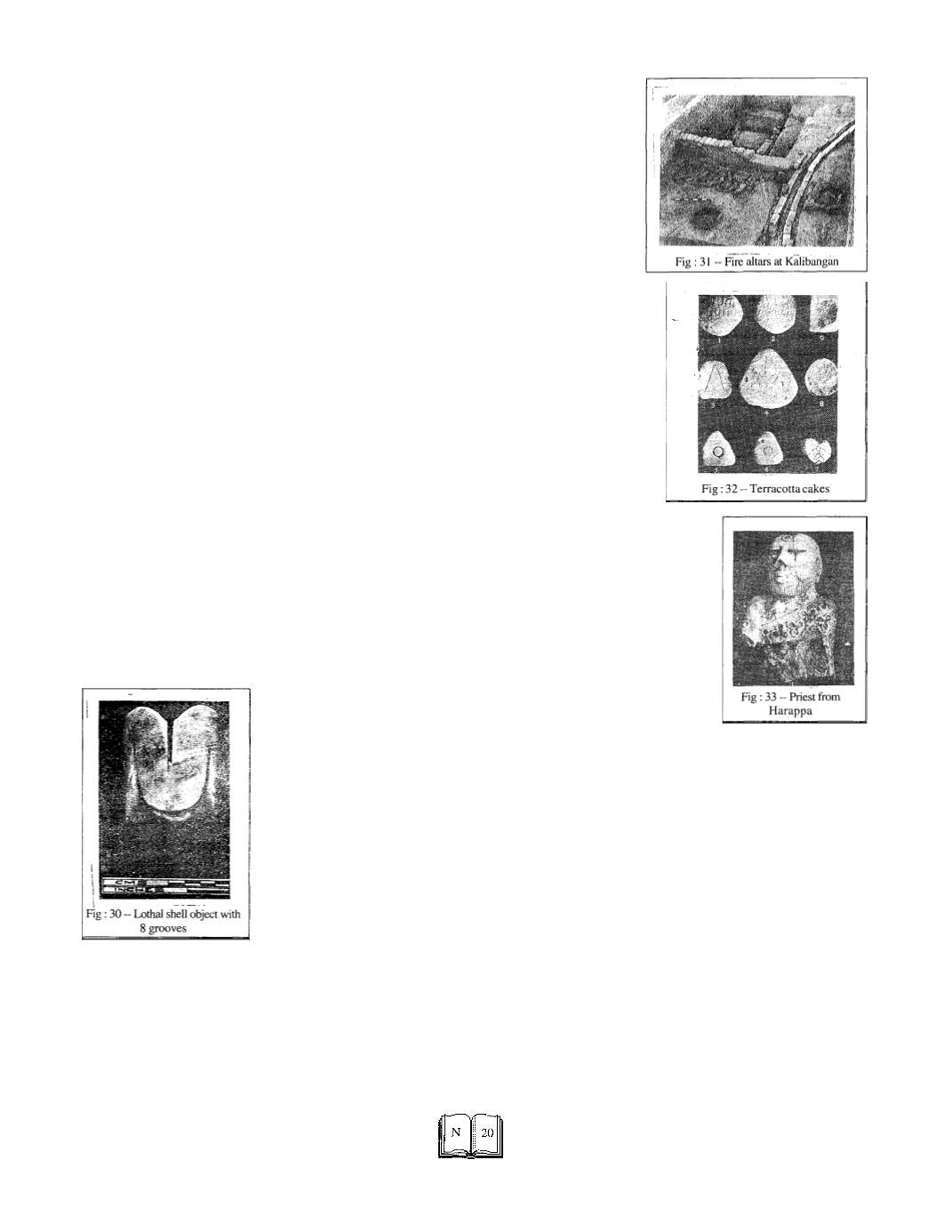

ARCHAEOLOGY
Eternal India
encyclopedia
namely V
2
, 1, 2, 4, 8, 10, 20, 30, 40, and 100. The smallest disc
weighs 50mg equal to a
dhanya
or
masaka
(V
2
gunja
) and 10
masakas
equal to a dhanya or
masaka
(V
2
gunja) and 10
masakas
equal to one
suvama masaka
of the
Arthasastra.
It weighs 5
Gunjas.
The unit 100 mg of Lothal gold discs runs in the ratio V
7
,1,
2
/
5
,5,10,25,27.5,30 and 32.5 with two variants 28 and 29. The unit
weight of 27.584g of the mature Harappans or 26.61 lg of Late
Harappans was, it appears, the basis for modelling the Greek
Uncia of 27.2g. The Indus decimal graduation continued in the
Vedic
period, for, the
Yajurveda
(Ch. 17, Verse 2) mentions the
decimal multiples 1 to 10.
The Indus length measure is determined by Mainkar on the
basis of the Mohenjo-Daro and Lothal scales. The Lothal scale
has smaller divisions 1.704 mm, while the length in the Mohenjo-
Daro scale is 6.705 mm. Four divisions of Lothal scale are equal to
one division on the Mohenjo-Daro scale. The greatest accuracy
was achieved in drawing 40 divisions in 68 mm on Lothal scalf. It
must have involved great skill and fine instruments to draw lines at
1,704mm distance in 2300 B.C. The practical use of the Mohenjo-
Daro—Lothal integrated scale can be demonstrated by measuring
the brick walls and foundations. The longest side of Lothal brick
(250rhm) is equal to 10 major graduations of the other scale within
limits of error. Mainkar has taken the distance between the 6th and
21st longer lines as the major division on Lothal scale. The width of
the wall of Lothal dock (1.04 m) is equal to 40 large graduations on
Lothal scale and the width of its foundation 1,78m is 1000 times the
small graduation (Rao S.R. 1985, 560-565, V.B. Mainkar,
1984,141-151). Brij Bhushan Vij says that the dimensions to
which the Great Bath of Mohenjo-Daro was constructed indicate
that the idea of angles and their trigonometric functions were within
the speculative imagination of the Harappan engineers and they
had perhaps the knowledge of the value of
pi
(Vij B.B., 1984, 153-
156).
Astronomy
Two hollow cylinders of conch
shell one from Lothal with 4 slits
each in the upper and lower margins
and the other from Dholavira with 6
slits each in the two margins were
used not only for measuring angles
of 45° (fig:30) and 30°, respec-
tively, but also for measuring
the
whole sections of the horizon
by
viewing the object through the
lower and upper slits. It could
serve as a compass as well as sex-
tant for navigators for ascertaining
the position of the star or sun, at its
helical rising.
Perhaps the
ring of 12 slits corresponds to the
Zodiac of
12
directions of wind arid division of the sky as in the
Vedic and later Greek Zodiac.
The
Sulba-sutras
which were a part of the
Srauta Sutras
are
geometric manuals for the construction of sacrificial altars. It is
interesting to find that in the rules given for construction of altars,
certain assumptions similar to the Euclidean postulates are taken
for granted (S.N. Sen 1971, 145). For instance that (1) a straight
line can be divided into an infinite number of equal parts is
archaeologically
attested
to by the very minute
divisions on the Lothal
scale. (2) that a circle can
be divided
into any
number of
parts
by
drawing diameters is also
borne out by the
terracotta floor tiles of
Kalibangan
on
which
circles are so divided. The
geometrical rules for the
construction
of
sacrificial
altars are followed in the
sienna citi
constructed by Sila
Varman at the ancient site of
Kalsi near Dehradun (IAR
1952-55). Similar rules must
have existed in Harappan
times for the construction of
fire altars at Lothal,
Kalibangan (fig: 31)
and
Rangpur.
Perphaps
these
correspond to the
Garhapatya,
Ahavaniya
and
Daksina agnis.
The seal No.320 from Harappa has a
fire-altar device and an inscription
reading
pag-bhag-arakaha
'seal
of
mighty God Arka' white seal No. 307
(fig : 27) from Harappa depicts a God in
an arch of flame. The inscription below
reads
bhag-rka
'God Arka'. Fire-
worship was popular at Lothal and
Kalibangan, where animal sacrifices
similar to the
gavam-ayana
of the
Brahmana (Aitrariya Br, IV. 17)
were
performed (Rao 1990, 284 ff). The
brick-built sacrificial altars contain
bovine bones, terracotta 'cakes' (fig:32) or lumps and in the case of
the Lothal altar a circular gold
rukma
was also found. A similar
ornament is seen on the forehead and arm of the statue of the
‘Priest’
from Harappa (fig:33).
The offering of a bull in Harappan sacrifice was later observed
only in a symbolic form in the Vedic
Gavamayana
sacrifice (Rao
1987,11). Maybe that
gavam
stood for the solar gait and the
sacrifice originally lasted for 360 days, but later on finding that the
year had 365V
4
days the suspension of the sacrifice for a certain
number of days was observed.
Two halls each with 3 altars in two different houses of the
Lower Town at Lothal answer to the description of
yajanasala.
The word
dama
is used for the hall in the Indus seals as well as
Brahmana
literature.
Sattra
is another cognate appearing in seal
inscriptions. It stood for a year-long sacrifice similar to the
gavam-
ayana.
N. Mahadevan observes that “by holding the session of
gavam-ayana
they also hold the walk of the
aditya.
The
Visuvan
{equinox)
occurred exactly in the middle of the
sattra.
The passage
Aghasu hanyante gave Arjunyo paryuhate
in
Aitareya Brahmana
suggests suspension of cow’s gait in
Maghas
and resumption in
Phalgunis
which could add 15 days more to the year of 350 days.
















